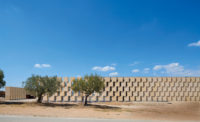Up until about a century ago, most buildings in France were made of stone. The introduction of béton armé changed all that, and concrete became an expression of modernity. Paris-based architect Carl Fredrik Svenstedt has designed a number of contemporary structures throughout the country in large blocks of stone, including the Domaines Ott winery in Provence, reimagining the age-old material. Now his latest, another striking winery project, has the plastic quality normally associated with concrete.
The Delas Frères winery is in the dense town center of Tain l’Hermitage on the left bank of the Rhône River in southeastern France, at the foot of terraced, sun-soaked hills that have yielded exceptional grape-bearing vines since Roman times, and that served as inspiration for a signature element of the new winery.
The site included a rundown manor house—renovated as a guest house with a restaurant and tasting rooms—and a garden once belonging to an old winemaking family, which Svenstedt has maintained as part of the winery’s identity. He designed a straightforward stone wineshop along the street-facing edge of the property, but the coup de théâtre is a 262-foot-long wall of waves at the opposite end of the garden, fronting the 34,000-square-foot wine-production facility.
The 23-foot-high structural facade is made entirely of load-bearing blocks of Estaillade stone, each weighing over 2 tons, extracted from farther down the Rhône. The blocks are held together horizontally by steel cables in grooves, as well as post-tensioned vertical steel cables that anchor the wall to the foundation. The design team considered other materials—analysis showed that building it in concrete would have used up four times more embodied energy—but the thermally inert stone was perfectly suited for this type of processing and storage facility, and did not require a complex wall assembly with cladding and insulation. “Stone turned out to be easier, less expensive, and more ecological,” explains Svenstedt.
The 20-inch-thick blocks were wire-cut and sculpted by a robot at a facility, just 20 minutes away from the site, that typically produces decorative stone fireplaces and balustrades. Muses Svenstedt, “If you can do it for classical architecture, why not something contemporary?” The porous limestone is softer and easier to cut than other rock types, especially right from the quarry, when still tender. It took three months to shape all the stone, which was installed by the same father-and-son team of masons that built Domaines Ott. Says Svenstedt, “They are artisans who are not afraid of technology.”
According to the architect, the design process happened backwards: he first drew the undulations intuitively, having “learned some tricks from the masons,” then input them in parametric software. A skylit, ramped area lies behind the curving wall, allowing vistors to discover the winemaking process and proceed up to the planted roof with views to the hills and town. Says Svenstedt, “The wall is the convergence of the whole project.”













Post a comment to this article
Report Abusive Comment